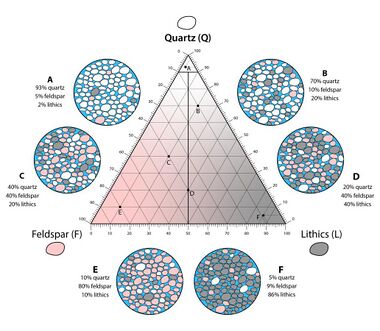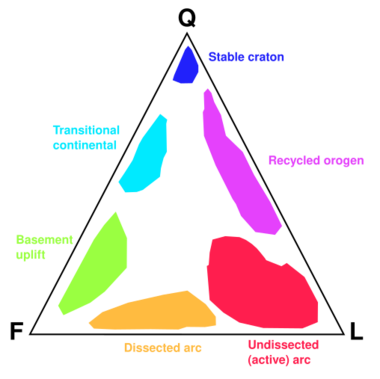Earth:QFL diagram
From HandWiki
A QFL diagram or QFL triangle is a type of ternary diagram that shows compositional data from sandstones and modern sands, point counted using the Gazzi-Dickinson method. The abbreviations used are as follows:
- Q – quartz
- F – feldspar
- L – lithic fragments
In general, the most contentious item counted is chert, which is usually counted as a lithic fragment, but is sometimes better suited in the Q pole. When this happens, the pole is renamed 'Qt' instead of Q.
The importance of a QFL triangle is mainly demonstrated in tectonic exercises. As first demonstrated in the 1979 paper by Bill Dickinson and Chris Suczek,[1] the composition and provenance of a sandstone is directly related to its tectonic environment of formation.
- Craton sands are clustered near the Q pole. As sandstones, these are known as quartz arenites.
- Transitional continental sands are along the QF line. As sandstones, these are known as arkoses.
- Basement uplift sands are near the F pole. This includes "thick-skinned tectonics." As sandstones, these are known as arkoses.
- Recycled orogen sands plot near the Q pole, but with significant F and L components. This includes "thin-skinned tectonics" common in subduction back-arc thrusting. As sandstones, these are known as lithic sandstones.
- Arc sands plot along the F and L line, with sometimes significant Q components. Clustering near the F pole indicates a dissected arc, and clustering near the L pole indicates an undissected, or new arc. As sandstones, these are known as arkoses and/or lithic sandstones.
See also
References
- ↑ Dickinson, William R.; Suczek, Christopher A. (December 1, 1979). "Plate Tectonics and Sandstone Compositions". AAPG Bulletin 63 (12): 2164–2182. doi:10.1306/2F9188FB-16CE-11D7-8645000102C1865D. https://pubs.geoscienceworld.org/aapgbull/article-abstract/63/12/2164/37163/Plate-Tectonics-and-Sandstone-Compositions1?redirectedFrom=PDF.
 |



